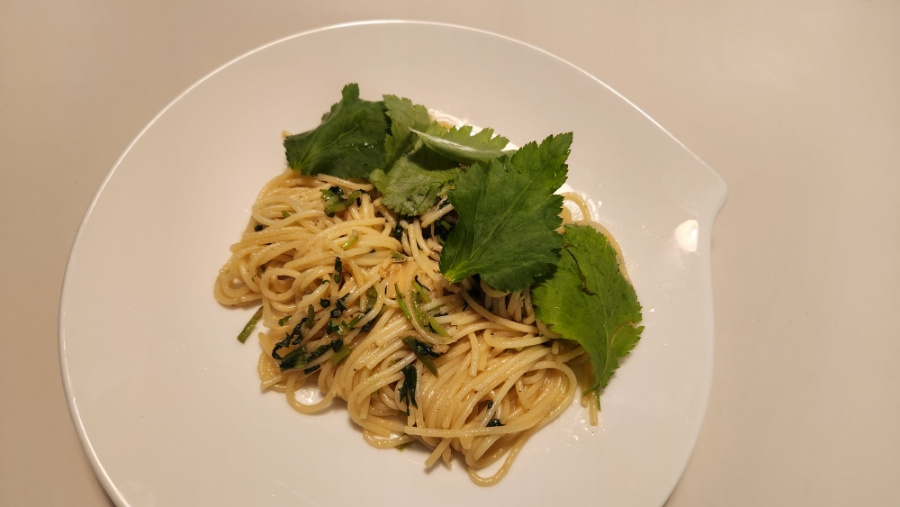Spring Aroma Bliss: Chan-namul & Sesame Oil Pasta Inspired by Lee Chan-won & Baek Jong-won
Recipe for Chan-namul (Wild Betony) and Sesame Oil Pasta: A Fusion of Celebrity Chef Styles

Craving a refreshing way to enjoy Chan-namul? This recipe combines the best of both worlds, inspired by Chef Lee Chan-won’s signature Chan-namul and sesame oil pasta from ‘Pyeonstorang’ and Chef Baek Jong-won’s approach to pasta dishes. The result is a ‘Chan-namul, Oyster Sauce, and Sesame Oil Pasta’ that’s an absolute triumph! Experience the vibrant, earthy notes of Chan-namul enhanced by the rich umami of oyster sauce and the nutty fragrance of sesame oil, all tossed with perfectly cooked pasta.
Main Ingredients- 1 serving of pasta (approx. 100g)
- 1 generous handful of fresh Chan-namul (wild betony, approx. 50g)
Seasoning & Other Ingredients- 1 Tbsp minced garlic
- 1 tsp oyster sauce
- 1 tsp chicken stock (or 2 Tbsp water)
- 2 tsp toasted sesame oil
- Olive oil, as needed (approx. 2-3 Tbsp)
- Salt, to taste
- Black pepper, to taste
- 1 Tbsp minced garlic
- 1 tsp oyster sauce
- 1 tsp chicken stock (or 2 Tbsp water)
- 2 tsp toasted sesame oil
- Olive oil, as needed (approx. 2-3 Tbsp)
- Salt, to taste
- Black pepper, to taste
Cooking Instructions
Step 1
First, prepare the Chan-namul. A generous handful, as pictured, is about right for one serving. It might look like a lot, but it reduces significantly when chopped. Typically, a standard package from the supermarket can yield 3-4 servings of pasta.

Step 2
Thoroughly wash the Chan-namul to remove any dirt or grit. It’s crucial to rinse it under running water at least three times to ensure it’s perfectly clean and fresh for your pasta.

Step 3
While the pasta water is coming to a boil, start preparing the Chan-namul. For one serving, add your pasta to a large pot of boiling water.

Step 4
Prepare the pasta water by boiling 1 liter of water and adding about 10 grinds of salt. A good tip is to taste the water: it should be about as salty as seawater. This ensures the pasta is seasoned from the inside out.

Step 5
Trim the Chan-namul. Discard any wilted or damaged ends from the stems. Set aside about one-third of the nicest leaves for garnishing later. Finely chop the remaining Chan-namul.

Step 6
Keep the larger leaves aside for garnish and the finely chopped leaves for cooking. Don’t worry about chopping the cooking portion too finely, as it will shrink when sautéed. Aim for relatively uniform pieces for a pleasing presentation.

Step 7
Now, let’s start sautéing. Heat a frying pan over low heat and add a generous amount of olive oil. Once the oil is shimmering slightly and just starting to bubble, add the minced garlic and sauté until fragrant.

Step 8
When the minced garlic turns a light golden brown and releases its aroma, add the chopped Chan-namul. Gently sauté the greens, ensuring they don’t burn, until they soften slightly.

Step 9
While the Chan-namul is sautéing, check on your pasta. It should be cooked ‘al dente’ – tender but still with a slight bite and a hint of translucency in the center. It’s time to get ready to drain it.

Step 10
Add the oyster sauce (1 tsp) and chicken stock (1 tsp) to the sautéed Chan-namul. If you only have one of these, you can use 2 tsp of the one you have. (Alternatively, you can use 2 Tbsp of water instead of chicken stock).

Step 11
*If you don’t have oyster sauce, fish sauce can be used as a substitute, but it will impart a slightly different flavor profile.

Step 12
Add the drained pasta directly into the pan with the Chan-namul and sauce. Reserve about a ladleful of the pasta cooking water. Toss the pasta vigorously in the pan, mixing it with the Chan-namul. Gradually add the reserved pasta water, a spoonful at a time, emulsifying the oil and water to create a light sauce that coats the pasta beautifully. This final cooking stage ensures the pasta reaches perfect doneness.

Step 13
Finally, season the pasta. Taste and add salt if needed. Grind fresh black pepper over the pasta for extra flavor. Turn off the heat, then drizzle in the toasted sesame oil and give it a final toss. This brings a wonderful nutty aroma to the finished dish.

Step 14
This recipe is wonderfully clean and focused on the natural flavors of the ingredients. The finishing touch of toasted sesame oil is absolutely essential for elevating the aroma and taste – don’t skip it!

Step 15
Twirl the pasta onto a plate for an elegant presentation. If the shape isn’t perfect, use the reserved Chan-namul leaves as a garnish to artfully cover any imperfections.

Step 16
The fresh, vibrant aroma of Chan-namul combined with the nutty fragrance of toasted sesame oil creates a truly addictive pasta. It’s a dish you’ll want to keep making over and over – a true spring delight!

Step 17
This recipe shares similar steps to a classic Aglio e Olio, making it a reliable and beloved choice for anyone who enjoys simple yet flavorful oil-based pasta dishes. It’s beginner-friendly and guaranteed to be delicious!




